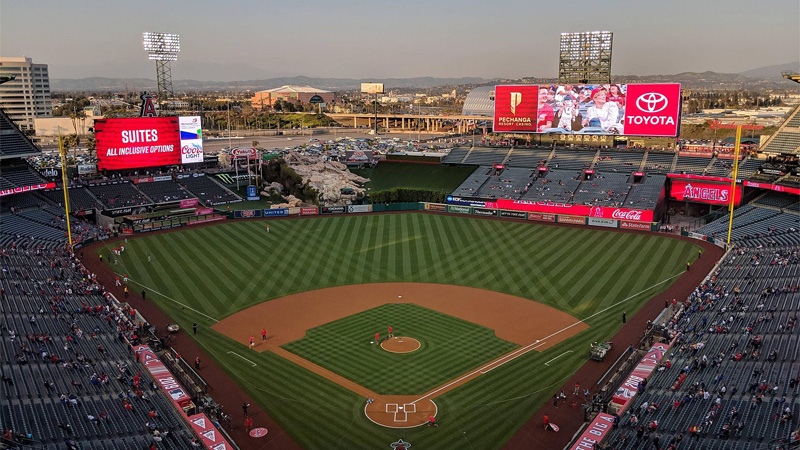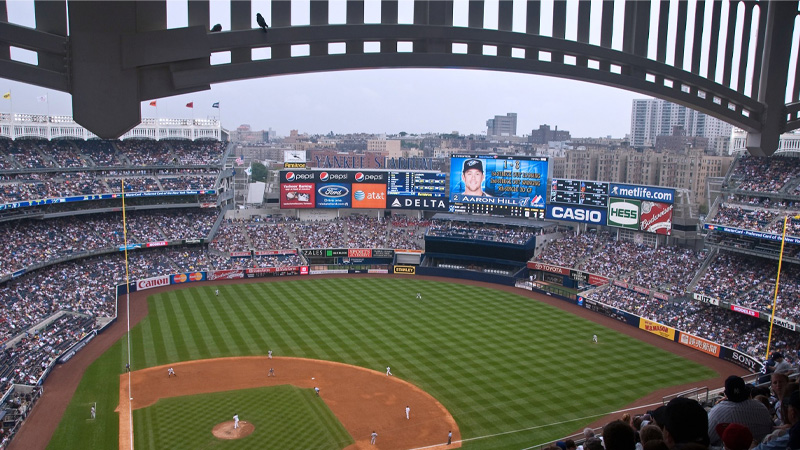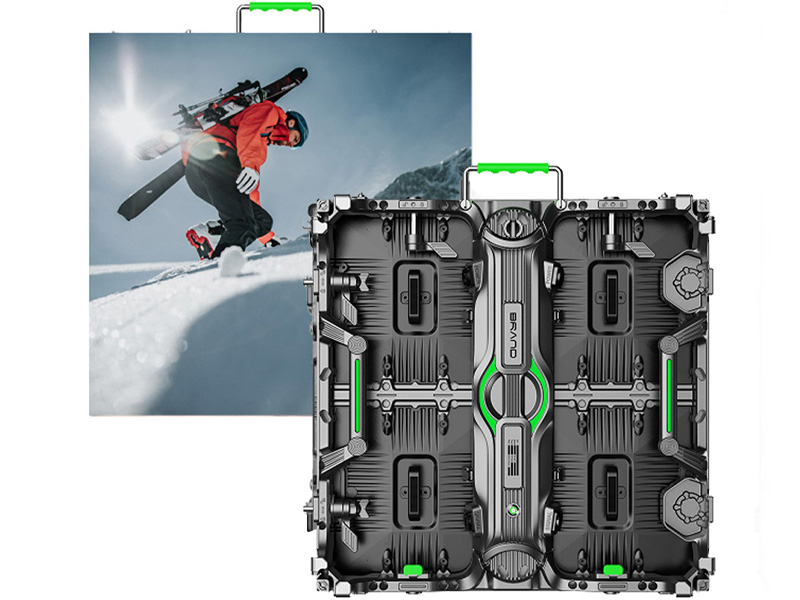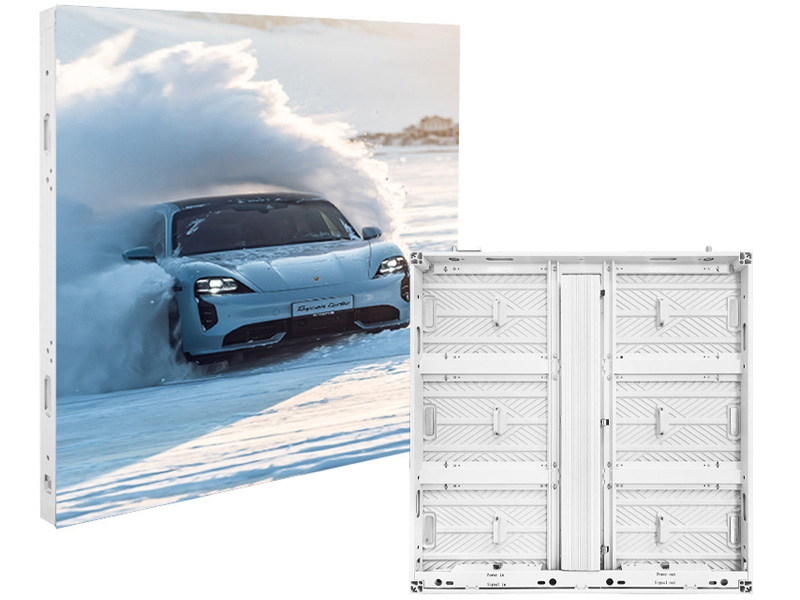Jumbotron – Buyer’s Guide 2024
The jumbotron is the most popular technology in sports arenas, offering an exciting experience for fans while generating significant advertising revenue. This article explores everything about jumbotrons and guides you on purchasing one that meets your needs.
Jumbotron is a large video screen used in sports arenas or concert venues to show close-up shots and playback of athletes or performers.
Synonym for jumbotron include jumbovision, jumbotron TV, or jumbotron screen. But these terms are gradually being replaced by definition terms like large screen displays, video walls, and led billboards.
You can see jumbotron in many public areas, such as New York Times Square, displaying advertisements or 3D videos. They are also used in famous entertainment and sport venues like Gillette Stadium, SoFi Stadium, and Yankee Stadium for live score updates during games.
Early arena scoreboards could only display simple text and numbers. Transforming from static images to dynamic video became a major focus for display technology companies.
Next, Mitsubishi Electric’s “Diamond Vision” screen debuted at the 1980 Major League Baseball All-Star Game(Los Angeles Dodger Stadium). Sony showcased this technology at the 1985 Tsukuba Expo with “Jumbotron”.
Jumbotron, meaning a large screen for public entertainment, advertising, sports info, and gaming venues, was used widely until Sony discontinued the trademark in 2001.
Early screens, including mini jumbotron, were all made in Japan. As labor costs in Japan rose, jumbotron production gradually shifted to Taiwan and China mainland.
The original jumbotron used CRT electron beams to generate images, similar to how early black-and-white TVs worked, with pixels in red, green, and blue colors .
However, CRT displays could only be used indoors; if placed outdoors or under sunlight, viewers couldn’t see the images clearly.
With the development of blue and green led technology, CRT displays were gradually phased out because led panels with the following advantages:
- Resolution is over 10 times higher than CRT;
- Lifespan is over 10 times longer than CRT;
- High brightness ensures clear visibility outdoors;
- Energy-saving and environmentally efficient;
- Can design to larger sizes or special shapes.
Jumbotron is widely used and increasingly popular in various settings:
-
Sports Arenas
Jumbotron was made for sports stadiums, displaying real-time scores, announcements, and thrilling replays to engage the audience. It also plays entertaining videos during breaks to liven up the atmosphere.
-
Concerts or Music Festivals
Jumbotron brings the performer’s passion to every corner, whether it’s dance moves or powerful singing, immersing every participant in the experience.
-
Gaming Rec Room
Imagine diving into a gaming scenario, battling beasts or experiencing high-speed car races, jumbotron can enhance these VR scenes.
-
Humbotron for Home
On a spacious backyard lawn, jumbotron plays “The Lion King” , bringing joyous weekend moments with your family.
-
Jumbotron Advertising
Ever dream of seeing yourself on a jumbotron in Times Square like the model? Now, for just $50 and 15 seconds of video, you can make that dream a reality.
-
Yankee Stadium Jumbotron
The mid-field scoreboard, manufactured by Mitsubishi Diamond Vision, measures 59 x 101 feet (31 meters) with a viewing area of 5,925 sqft (550.5 sqm). It can display video across its entire area and simultaneously show four 1080p HD images.
-
Dallas Cowboys Jumbotron
A highlight of AT&T Stadium is its massive central high-definition television screen, measuring 160 x 72 feet (49 x 22 meters) and covering 11,520 sqft(1,070 sqm). This surpasses the screen installed at Kauffman Stadium in Kansas City after its 2009 renovation, which was 8,736 sqft (812 sqm), making it the largest scoreboard screen in the world.
-
MSG Sphere Jumbotron
Currently, the biggest Jumbotron in the world is the MSG Sphere at the Venetian Resort in Las Vegas. It features a 580,000 sqft outdoor spherical screen and a 160,000 sqft 16K resolution immersive indoor led display, completed jointly by Populous and SACO Technologies.
As with its many uses, you might wonder how much a jumbotron price. Here’s a breakdown of the costs:
-
LED Display Panels
The process is as follows: LED → LED Module → LED Panel → Jumbotron.
The cost of led panels depends on pixel pitch, resolution, size, and energy efficiency, led tiles typically make up 60-80% of the total project cost.
-
Control System
To transfer images and videos from the venue to the screen, professional equipment such as cameras, control computers, DVD players, video matrix controllers, video processors, and fiber optic transceivers are needed. These components account for 5-10% of the total cost.
-
Sound System
A music or sports event without sound is dull, so a suitable sound system is essential to hear audience cheers and enhance the experience. This typically makes up 1-3% of the cost.
-
Structural Support
Jumbotrons are secured high above venues using steel frames or truss systems to ensure they withstand severe weather conditions like rain and hurricanes, and will not collapse or fall. This structural support, along with installation costs, accounts for 10-15% of the total cost.
-
After-Sales Service
Even electronic products need after-sales service. Your jumbotron should have 3-5% spare parts available for timely replacement, along with associated labor costs.
| Example: Installation Cost in High School/College Sports Stadium | ||
| Project | Cost Range | Cost Percentage |
| LED Display Panels | $200,000 – $250,000 | 60-80% |
| Control and Sound Systems | $10,000 – $20,000 | 5-10% |
| Installation Structure | $50,000 – $80,000 | 10-15% |
| After-Sales Service | $10,000 – $20,000 | 3-5% |
| Labor Costs | $20,000 – $30,000 | 5-8% |
For most sports stadiums, it’s best to buy a jumbotron because they are fixed in place and won’t need to be moved. Send us your project’s size, resolution, and other requirements, then our expert sales team will give you a fair price.
For concerts, religious gatherings, or festivals where the stage needs to be set up on-site and easily movable, renting a jumbotron is more suitable.
Rental costs typically range from $2,000 to $5,000 per day depending on the size needed, rental duration, event location, and transportation fees.
Many local AV companies offer jumbotron hire service, also you can buy it from us and rent out yourself.
![]() Front Convenient Maintenance
Front Convenient Maintenance
![]() Cabinet Size: 500*500/1000mm
Cabinet Size: 500*500/1000mm
![]() Best Partner for Concert Jumbotron
Best Partner for Concert Jumbotron
![]() With 3 Years Warranty and 5% Spare Parts
With 3 Years Warranty and 5% Spare Parts
![]() Best Jumbotron for Sports Arenas
Best Jumbotron for Sports Arenas
![]() Cabinet Size: 960*960mm
Cabinet Size: 960*960mm
![]() Compatible with 480*320mm Module
Compatible with 480*320mm Module
![]() With 3 Years Warranty and 5% Spare Parts
With 3 Years Warranty and 5% Spare Parts
In short, to take your advertising to the next level, our jumbotron is your best choice. Don’t miss this game-changing opportunity. Purchase our Jumbotron and make your event shine brightly!
Contact
 Building D, Hongfa Science Park,
Building D, Hongfa Science Park,
2035 Songbai Road, Shiyan, Bao’an District, Shenzhen, Guangdong, China.










